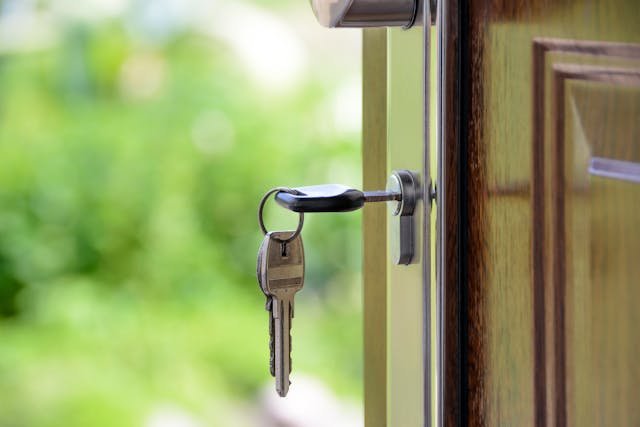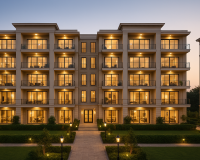In recent years, the concept of contemporary living has evolved dramatically. What began as a pursuit of sleek, modern design has transformed into a harmonious blend of aesthetics and sustainability. The Rise of Contemporary Living is no longer just about stylish interiors but about creating eco-friendly spaces that embrace luxury and modern conveniences. This new wave of housing, especially prominent in urban areas, is redefining what it means to live luxuriously while remaining environmentally responsible.
Defining Contemporary Living
At its core, contemporary living refers to a lifestyle that embraces modern design, innovative technology, and sustainability. It places importance on open spaces, natural light, and the efficient use of resources. A significant aspect of this trend is how it seamlessly integrates luxury with eco-friendly solutions, creating homes that are not only beautiful but also sustainable.
For example, luxury apartments with swimming pools are no longer just architectural marvels but also include eco-friendly designs, from energy-efficient lighting to water conservation systems. These apartments offer a balance between opulence and environmental responsibility, setting the stage for a more sustainable future.
Elements of Modern Aesthetics
Modern aesthetics play a vital role in the Rise of Contemporary Living. The use of clean lines, minimalist design, and neutral color palettes creates an environment that feels both luxurious and calming. Open floor plans, large windows, and natural materials like stone and wood are staples of this style. The goal is to create spaces that are not only functional but also visually appealing.
Moreover, contemporary homes often feature smart technology that enhances convenience while reducing energy consumption. From automated lighting systems to smart thermostats, these technologies help homeowners live more efficiently without compromising on luxury.
The Role of Sustainability in Contemporary Living
Sustainability is now a crucial component of contemporary living. The focus is on reducing the carbon footprint of homes by using renewable energy sources, energy-efficient appliances, and sustainable building materials. The Rise of Contemporary Living is closely tied to the global push towards eco-friendly lifestyles.
For instance, Luxury housing projects now incorporate green technologies such as solar panels, rainwater harvesting, and waste recycling systems. These initiatives not only reduce environmental impact but also contribute to significant cost savings for homeowners.
In areas like Gurgaon, where luxury real estate is booming, developers are increasingly adopting sustainable practices. Luxury apartments with swimming pools are being designed with solar heating systems to reduce energy consumption, while green spaces are carefully curated to enhance biodiversity and air quality.
Sustainable Architecture and Design
Sustainable architecture is a hallmark of contemporary living. Buildings are designed to maximize energy efficiency through passive solar design, natural ventilation, and the use of renewable resources. The construction process itself emphasizes sustainability by utilizing eco-friendly materials such as reclaimed wood, bamboo, and recycled steel.
Incorporating sustainability into design extends beyond energy efficiency. Water conservation techniques, such as greywater recycling and low-flow fixtures, are becoming standard features in contemporary homes. This integration of sustainability with design is a key aspect of the Rise of Contemporary Living, making it a more responsible and appealing choice for modern homeowners.

Luxury Meets Sustainability in Urban Areas
Urban regions, particularly those experiencing rapid growth, are prime examples of how contemporary living is transforming real estate. Cities like Gurgaon are witnessing an increase in luxury real estate developments that cater to the growing demand for modern, eco-conscious homes.
The Appeal of Gurgaon’s Luxury Real Estate
Gurgaon, a city known for its rapid development and upscale housing options, exemplifies the Rise of Contemporary Living. Here, the demand for apartments in Gurgaon that offer both luxury and sustainability is at an all-time high.
The city is home to numerous luxury housing projects that combine cutting-edge design with eco-friendly features. These projects offer a range of amenities, from luxury apartments with swimming pools to state-of-the-art fitness centers, all while maintaining a strong focus on environmental responsibility.
Moreover, luxury real estate in Gurgaon is designed to meet the needs of modern professionals and families who seek convenience, comfort, and a commitment to sustainability. With smart home technology, eco-friendly construction practices, and abundant green spaces, these homes are setting new standards for contemporary living.
Why Contemporary Living Appeals to Urban Homeowners
The Rise of Contemporary Living is largely driven by the desire for homes that reflect the values of modern homeowners. Today’s buyers are not just looking for opulence; they want homes that are aligned with their environmentally-conscious lifestyles. This shift in priorities has led developers to incorporate sustainable practices into their projects.
For example, luxury housing projects in urban areas often feature rooftop gardens, green walls, and energy-efficient infrastructure. These additions not only contribute to the sustainability of the building but also enhance the well-being of residents by improving air quality and providing natural spaces for relaxation.
The integration of green spaces, renewable energy systems, and eco-friendly technologies into apartments in Gurgaon is a testament to the city’s commitment to contemporary living. These features are not just trends; they are becoming the standard for luxury housing in urban areas.
The Future of Contemporary Living
As we look ahead, the Rise of Contemporary Living is expected to continue shaping the housing market. The fusion of modern aesthetics and sustainability will remain at the forefront of residential design, with more emphasis on creating eco-friendly homes that enhance the quality of life.
Developers will likely explore new ways to integrate smart technology and sustainable materials into their projects. For instance, advances in renewable energy and water conservation systems could further reduce the environmental impact of luxury homes.
The Role of Smart Technology
Smart technology is set to play an even bigger role in the future of contemporary living. Home automation systems, energy management tools, and smart security solutions are becoming increasingly common in luxury housing projects. These technologies not only add convenience but also help homeowners reduce their energy consumption and live more sustainably.
Furthermore, smart home devices can optimize energy use by adjusting lighting, heating, and cooling based on occupancy and environmental conditions. This level of control ensures that homes remain energy-efficient without sacrificing comfort, aligning perfectly with the principles of contemporary living.
Conclusion
The Rise of Contemporary Living represents a profound shift in the way we think about our homes. No longer is luxury synonymous with excess; today, it is about blending modern design with sustainability. From luxury apartments with swimming pools to innovative luxury housing projects, contemporary living is redefining the standards of comfort, style, and environmental responsibility.
In cities like Gurgaon, the demand for luxury real estate that incorporates sustainable practices is growing. The future of housing lies in homes that offer not only modern aesthetics but also eco-friendly solutions. As we move forward, the Rise of Contemporary Living will continue to influence how we build and inhabit our spaces, creating a future where luxury and sustainability coexist harmoniously.





